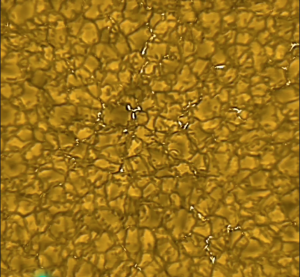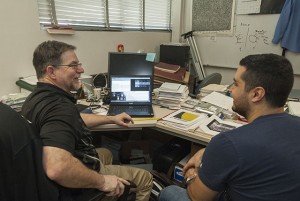CSUN Prof’s Research Efforts May Solve Solar Mystery in the Sun’s layers
Captured images show the highest-resolution representations of the magnetic field of the so-called “quiet” surface of the sun. They reveal a new, complex, snake-like pattern of energy in the magnetic field, in addition to “loops” observed previously. Researchers collected ground-breaking data with the US National Science Foundation’s new Daniel K Inouye Solar Telescope (DKIST) in Hawaii.

Small-scale magnetic structures of the ‘quiet sun’ at high resolution. Credit: DKIST
The analysis was carried out in partnership with an international group of experts from: the Queen’s University Belfast, UK; the National Space Observatory, USA; the National Centre for Atmospheric Research, USA; the Max Planck Institute for Solar System Research, Germany; Sheffield University, UK; Eötvös Loránd University, Hungary and CSUN.
It might also help explain why the outermost layer of the sun (‘corona’) is millions of degrees, but the sun’s surface (‘photosphere’) is only about 6000 degrees, even though the opposite would be expected, according to Christian, co-investigator the project.
“Typically, you buy a cup of coffee, and it cools off after a while but here, you have some heating mechanism inside the sun that’s heating this outer atmosphere, and it’s just not important for the sun,” Christian said. “There are billions of stars that have a corona like our sun and they’re being heated by this or some type of magnetic waves.”
Previously, much of the research into the heat variations between the sun’s corona and photosphere has focused on “sunspots” – large, highly magnetic and active regions, often comparable to Earth in size – that can act as conduits for energy between the Sun’s outer layers, Christian said. However, for the new study, the team looked away from sunspots and focused on quieter regions of the sun.
These quiet areas of the photosphere are covered by convective cells called granules that are host to weaker but more dynamic magnetic fields than found around sunspots. Previous observations have indicated that these magnetic fields are organized in small loops, but researchers found a more complicated underlying pattern for the first time, with the orientation of these magnetic fields showing a “serpentine variation,” Christian said.

CSUN solar astronomer Damian J. Christian, left, discusses solar flare data with physics graduate student Menoa Yousefi. Photo by Ruth Saravia.
To measure the sun’s weak magnetic fields, he said, overly sensitive instruments are needed. Since the magnetic fields cannot be directly measured, researchers instead measured the imprint they leave on the light emitted in their presence. The magnetic fields polarize the light, generating signals that are less than half a percent of the size of intensity measurements. High-resolution observations are required to see this, which is where DKIST comes in.A key question, Christian said, is then, “how common serpentine magnetic-field configurations are and how far they can permeate into higher layer?, If we know this, we can assess their contribution to chromospheric heating. To do this, more observations are needed, like those possible with the DKIST.
“The sun is the most important astronomical object for humankind with solar activity driving space weather and having possible devastating effects on our technological grid and infrastructure,” Christian said. “This discovery is huge and will lead us closer to understanding one of the biggest conundrums in solar research.”
The research has been published in Astrophysical Journal Letters and was supported by research funding from the Science and Technology Facilities Council which is part of UK Research and Innovation, Horizon 2020 and the NSF.

 experience
experience